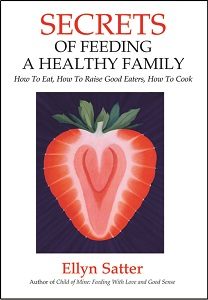

Family Meals Focus
The Ellyn Satter Institute Newsletter
Eat what you like and be healthy!
by Ellyn Satter, MS, MSSW, Dietitian and Family Therapist
For a PDF of this newsletter, click here
Dietary Guidelines for Americans 2020-2025 has been published. The same as it has for the last 5 decades, the Dietary Guidelines for Americans says to eat more of a variety of fruits, vegetables, whole grains, low-fat protein foods, and less sugar, salt, and saturated fat. As illustrated by the table below, ecSatter accomplishes US Dietary Guidelines, you don’t have to get caught up in eat-this-don’t-eat-that in order to be healthy. Instead, manage your eating in a kinder, gentler way.
Work with your body, not against it
Respect your physical need for filling and sustaining food, honor your emotional need for pleasure, and celebrate your social need for sharing favorite foods with those you love. These recommendations are based on strong and convincing evidence. Even though ecSatter doesn’t say what and how much to eat or what to weight, those who are Eating Competent consume more nutritious, higher quality diets (and higher Healthy Eating Index scores), are more active, sleep better, have better medical and lab tests, have the same or lower BMI, and do better with respect to feeding their children. In fact, the evidence is strong enough to support using ecSatter for medical nutrition therapy.
Combine structure with food enjoyment; Nutritional adequacy and dietary quality fall into place.
Emphasize the joy of eating
Instead of counting, measuring, restricting, and avoiding, ecSatter is based on a biopsychosocial strategy: build on the joy of eating. Feed yourself faithfully; give yourself permission to eat. Take time to eat, pay attention, and eat as much as you want of food you enjoy. As you combine structure with food enjoyment, nutritional adequacy and dietary quality fall into place.
Steps to wellness based on Eating Competence
- Make your eating important. Have family meals and snacks between times made up of foods you enjoy. Eat as much as you want at those regular times.
- Eat food you enjoy. Use fat, sugar, and salt to make food tasty and rewarding. You will eat a variety of fruits, vegetables, grains, dairy, and protein foods because you enjoy them, not because you have to. You will also eat less sugar, salt, and fat.
- Include your sugary beverages and “forbidden foods” at meals and snacks. Compared with munching and sipping along, you will consume less fat and sugar (and be kind to your teeth).
- Address saturated fat by using a variety of fats: Butter, cream and gravy; margarine and mayonnaise; olive, canola oil, corn, or soybean oil.
- Trust yourself to learn and grow. The Satter Hierarchy of Food Needs illustrates that, once you get enough to eat of food you enjoy, you tire of even favorite food and seek variety. Variety, of course, is the basis for a nutritionally excellent diet.
- Let your body weigh what it wants to weigh. Evidence shows that weight stability supports health; Weight yo-yoing doesn’t.
Explore
Ellyn Satter’s Secrets of Feeding a Healthy Family says the secret of raising a healthy eater is to love good food, enjoy eating, and share that love and enjoyment with your child. When the joy goes out of eating, nutrition suffers.
ecSatter accomplishes US Dietary GuidelinesAchieve and maintain good health; reduce the risk of chronic disease
|
||
| Satter Eating Competence Model | Dietary Guidelines | |
| Guidelines↓ Strategy→ | Biopsychosocial | Food selection formula |
| Follow a healthy eating pattern | Support moderation by emphasizing regular, reliable, and rewarding meals and sit-down snacks made up of familiar and enjoyable food. Be considerate without catering with meal planning, working toward meals including basic food groups. | Give calorie-based guides on what to eat, daily food plan, portion sizes, numbers. No emphasis on meals. |
| Emphasize nutritious foods and beverages | Encourage no-strings-attached food enjoyment. Expect natural tendencies to gradually increase dietary variety as outlined in Satter’s Hierarchy of Food Needs. Food security and monotony and stimulate increased dietary variety. | Say what to eat, give a daily food plan, give portion sizes, numbers of servings. Enjoyment as part of an agenda: Enjoy healthy food; enjoy a healthy diet. |
| Increase vegetables | Emphasize pleasure. Introduce the possibilities. Find practical and enjoyable ways to include vegetables in family meals; let family members eat or not eat. | Say what to eat, give portion sizes, numbers of servings. |
| Increase fruit | Emphasize pleasure. Introduce the possibilities. Find practical and enjoyable ways to include fruit in family meals; let family members eat or not eat. | Outline what to eat, give portion sizes, numbers of servings. |
| Consume appropriate calorie level | Eat as much as desired based on hunger, appetite and satiety. | Prescribed number of calories outlined in daily food plan: what to eat, portion sizes, numbers. |
| Achieve and maintain healthy weight | Support the individual’s own natural weight as it grows out of eating competence in combination with positive and sustainable activity. | Strive for a BMI of 25 or less. Avoid overweight and obesity. |
| Limit fat and sugar | Support moderation by emphasizing enjoyable, structured meals and snacks. Encourage using fat and sugar to make food taste good and as a low-cost way to satisfy calorie needs. | Avoid fatty and sugary foods. Avoid extra fat and sugar. Emphasize restriction and avoidance: portion sizes, numbers of servings. |
| Increase oils; Limit saturated fat | Encourage using a variety of fat sources to make meals taste good and to satisfy calorie needs. | Impose a limit on saturated fat. |
| Limit sodium | Support moderation by emphasizing enjoyable, structured meals and snacks. Encourage using sodium as a condiment to make meals, including nutritious foods, taste good. | Impose a limit on sodium. |
| Sustainability | Enjoyment and food-seeking are sustainable. | Food avoidance and restriction are not sustainable. |
| Eating competence | High. Individual supported in retaining internal regulation of food intake, developing food acceptance capabilities, and stabilizing weight. Eats nutritious food for enjoyment. Attitudes about food and eating are likely to be positive. | Low. Dietary prescriptions tend to deny or overrule hunger, appetite, and satiety, cause cycles of restriction and overindulgence. Attitudes about food and eating likely to be negative. |

